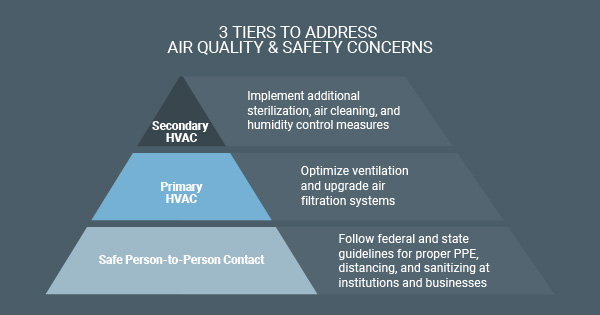Turning Recommendations into Actions Part 2: Primary HVAC Considerations
Our HVAC experts are working in step with our clients to navigate the changing technical information about the air quality in schools and businesses during the pandemic. Each client needs a plan specific to their facility, but how do you prioritize the ever-evolving recommendations? We’re focusing on a multi-step approach that can help prioritize the actions facilities need to take when assessing the effectiveness of an HVAC system (illustrated below).

An important concern associated with the risk of COVID-19 infection is indoor air quality (IAQ) which directly relates to the functionality of a facility’s HVAC system. Ventilation and air filtration systems are primary contributors to a building’s IAQ. Review of these components of an HVAC system should be a top priority when reopening a facility, and deficiencies addressed expeditiously.
Optimizing Ventilation
There are several considerations when discussing how to optimize ventilation within a facility. Here are two factors to talk to your HVAC specialist about when formulating your game plan:
- More ventilation air vs. room air: Using more ventilation air, and recirculating less room air, not only reduces virus transmission concerns but also has a strong positive effect on the cognitive function, productivity, and well-being of building occupants. The American Society of Heating, Refrigerating and Air-Conditioning Engineers (ASHRAE) recommends starting from a baseline of ASHRAE Standard 62.1, Ventilation for Acceptable Indoor Air Quality.
- Optimizing the ventilation rate: Improving the ventilation rate for a given space can be accomplished by increasing supply air volume, improving ventilation effectiveness, reducing the number of people in the space, or any combination of the three. The first two options would require mechanical changes to the systems, where the third option does not.
- Testing and balancing ventilation airflow rate: How much ventilation air is your system delivering to your building? Do you have a dated system that hasn’t been tested or air balanced recently? Are your outdoor air damper actuators functioning properly? When’s the last time your airflow stations have been calibrated? The only way to know how much ventilation air your system is providing is to have your air handler tested and balanced by a professional Testing and Balancing (TAB) Contractor. Tighe & Bond works with clients to define the outdoor airflow rates your system should be balanced to and collaborates with TAB Contractors to help your system deliver the proper quantity of outdoor air, which is critical to help provide healthy indoor air quality.
Upgrading Air Filtration
Filtration is used to clean the air by trapping airborne contaminants that could be recirculated through an air handling system or brought in from outdoors. Our engineers are continuing to monitor ASHRAE air filtration recommendations closely. When looking at upgrading an air filtration system consider the recommendations from the latest ASHRAE Position Document on Infectious Aerosols which include using enhanced air filtration, with higher minimum efficiency reporting value (MERV) rating than what has historically been considered the “industry standard”. Filters with higher MERV ratings are generally more effective at capturing airborne particulate at smaller sizes, but also tend to have successively greater pressure drops associated with them. It is important to consider and evaluate the impact of additional pressure drop on a case-by-case basis.
For more information on engineering solutions to improve indoor air quality, stop back to our News area and follow us on social to read more in our series “Turning Recommendations into Actions” or contact a member of our Building Services engineering team.
Tags: air filtration, COVID-19, HVAC, IAQ, safety, ventilation


